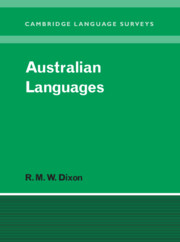Book contents
- Frontmatter
- Contents
- List of maps
- List of abbreviations and conventions
- Preface
- Acknowledgements
- Conventions followed
- List of languages and language groups
- 1 The language situation in Australia
- 2 Modelling the language situation
- 3 Overview
- 4 Vocabulary
- 5 Case and other nominal suffixes
- 6 Verbs
- 7 Pronouns
- 8 Bound pronouns
- 9 Prefixing and fusion
- 10 Generic nouns, classifiers, genders and noun classes
- 11 Ergative/accusative morphological and syntactic profiles
- 12 Phonology
- 13 Genetic subgroups and small linguistic areas
- 14 Summary and conclusion
- References
- Index of languages, dialects and language groups
- Subject index
14 - Summary and conclusion
Published online by Cambridge University Press: 22 September 2009
- Frontmatter
- Contents
- List of maps
- List of abbreviations and conventions
- Preface
- Acknowledgements
- Conventions followed
- List of languages and language groups
- 1 The language situation in Australia
- 2 Modelling the language situation
- 3 Overview
- 4 Vocabulary
- 5 Case and other nominal suffixes
- 6 Verbs
- 7 Pronouns
- 8 Bound pronouns
- 9 Prefixing and fusion
- 10 Generic nouns, classifiers, genders and noun classes
- 11 Ergative/accusative morphological and syntactic profiles
- 12 Phonology
- 13 Genetic subgroups and small linguistic areas
- 14 Summary and conclusion
- References
- Index of languages, dialects and language groups
- Subject index
Summary
It is commonly asserted that Aboriginal people have been in Australia for at least forty thousand years and probably for fifty thousand years. This is misleading. What should be said is that people have been in the Australia/New-Guinea land mass for this period of time. The first settlers are likely to have rapidly expanded in numbers, making use of the land area and food resources available. The expansion would have led to split of political groups, and of languages. During the initial period of punctuation (which may have lasted for just a few thousand years) it is likely that a family tree diagram would have appropriately modelled the relationships between languages.
But the initial phase of expansion was completed long ago. It was followed by some tens of thousands of years of an equilibrium situation, where the number of languages would have remained more-or-less static, with cultural and linguistic features diffusing across geographical regions. The Australia/New-Guinea land mass divides into two major regions: (a) most of present-day Australia, together with the south-west part of New Guinea, consists of relatively open, flattish, dryish country; (b) most of New Guinea, plus a strip of north-east Australia, is – in contrast – forested, mountainous and well watered. As is the case elsewhere in the world, we find more linguistic diversity in area (b), where communication is rather difficult, as against area (a), where communication is relatively easy.
- Type
- Chapter
- Information
- Australian LanguagesTheir Nature and Development, pp. 690 - 699Publisher: Cambridge University PressPrint publication year: 2002

